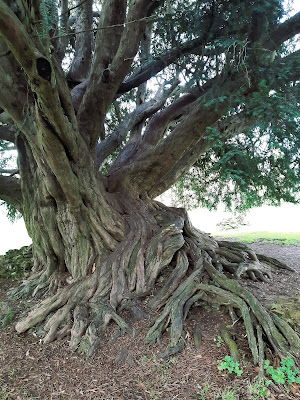'No fucking about now', said the Northerner in a stern and northern way as I fastened my seatbelt. 'Just straight there and straight back, ok?'
But a 340-mile round trip driving one of the offspring back to near Brighton in dreary midwinter's not much fun without at least a bit of a treat. And I don't mean an M&S Wensleydale and carrot chutney sandwich from Chieveley Services either (though they are my preferred fare on long drives). So we made the outward journey shorter, though a little longer timewise, by coming off the M4 at Reading and taking the A33 through the top right-hand corner of Hampshire to Waverley Abbey in Surrey, which has a nice tree.
I barely know the Home Counties, but as I drove past a turning called Old Compton Lane, this patch at least began to look familiar, and I wondered if I'd been there before. Could we be anywhere near Watts Gallery and Lady Mary's Chapel, not forgetting Guildford Cathedral, which I'd visited with poet friends a considerable number of years ago? And godawfully charming Godalming? It was only when I got home that I could look up the locations, and yes, we were little more than a stone's throw from all of these spots, which is the trouble with letting Google Maps plan your journey, instead of poring over an atlas: the places are more difficult to join up in your memory.
Anyway. We were on a mission to see the yew tree that won the Woodland Trust's UK Tree of the Year competition in 2022, and if there were a few mediaeval eccelsiastical ruins to take in at the same time, so much better. It had even stopped raining, more or less, and there were plenty of red kites about, which was a bonus.
Our route to the yew and the ruins took us along the side of a picturesque man-made lake, which, the map later suggested, is fed by the nearby River Wey. The skies were stormy with alternating scuds of rain and sun.
We also passed Waverley Abbey House, for which the moody Abbey ruins, along with the lake, became a landscape feature in its grounds, but which is of much less interest to me.
So, yes, the first Abbey in the country founded by the Cisterian religious order in 1128, and extant until 1536, when, inevitably, it was trashed on the orders of Henry VIII during the Disillusion of the Monasteries, as my daughter put it.
The vaulted refectory
A high water marker, set at waist height, and inscribed 16th September 1968, the date of the Great Flood in the south-east
lots of graffiti in the refectory
goose fly-past
the monks' dormitory
The yew tree postdates the dissolution of the monastery, and is believed to be nearly 500 years old.
Because there are so many more ancient yews than this merely venerable (though very pleasingly-shaped) tree, I wonder if it's the setting that won the competition for the Waverley yew. We know parts of the Abbey were demolished rather than left to fall, as much of its stone was used in other, nearby buildings, so the yew could have been planted, by person or bird, on the razed walls of the Abbey Church shortly afterward its destruction - and given the species' connection with spiritual and religious places, what a powerful symbol its flourishing is.
The abbey church was huge, by the way: right up to the furthermost walls in this photo.
It strikes me, looking at the list of trees that have won the various Tree of the Year competitions, that triumph is no guarantee of survival. Some of the trees that are nominated are included because they're in danger of being felled and it's a good way of drawing attention to their plight. Of these some still stand, like the Brimmon Oak in Wales - I remember signing a petition to save that one. But the Cubbington Pear, which was England's Tree of the Year in 2015, was felled in 2020 (on my birthday😞) to make way for the HS2 railway line; the Happy Man Tree, which won the same competition in 2020, was felled by developers the following year, and the pain caused by the wanton destruction of the 2016 winner, the Sycamore Gap Tree, last September is still felt by many.
To which we say, may the lovely Waverley yew stand for thousands of years.







































































